Cemtech Asia
Cemtech Asia 2015 conference and exhibition was held at the Grand Hyatt Bangkok, Thailand, on 21-24 June. Tapping into southeast Asia, one of the world’s fastest-growing economic regions, Cemtech was a popular destination for the region’s senior professionals. Sponsored by SCG Cement and featuring a tour of its impressive Kaeng Khoi plant, the meeting attracted 200 delegates from 35 countries.
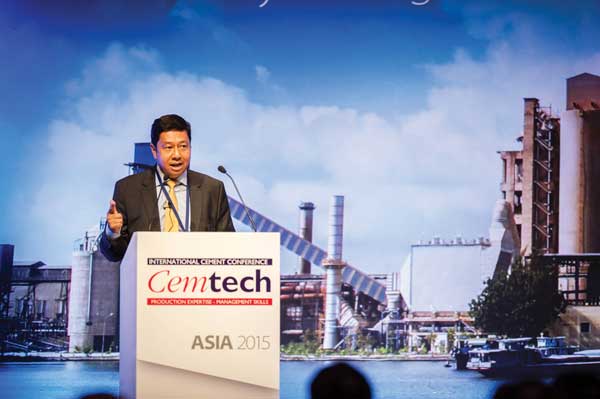
Nithi Patarachoke, vice president, SCG Building Materials Co Ltd (Thailand),
provided the keynote presentation with a view on the Thai cement industry
Following an evening reception and welcome dinner for guests arriving from all over the world to attend Cemtech Asia, the conference opened on Monday morning with a keynote presentation delivered by Nithi Patarachoke, vice president, SCG Building Materials Co Ltd (Thailand), which controls a 41 per cent share of Thailand’s cement market. SCG Cement is optimistic that demand will expand from 34.5Mt in 2014 to 35.2Mt in 2015.
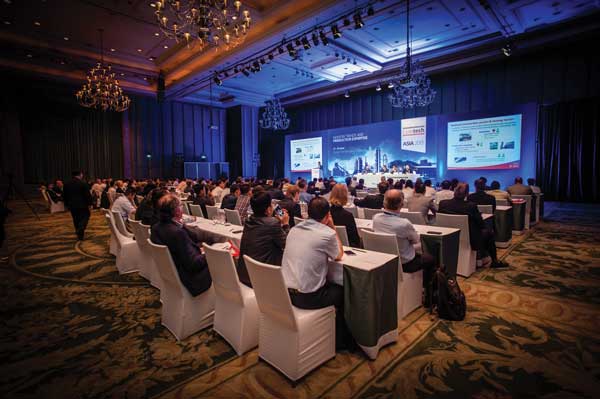
Cemtech Asia attracted 200 delegates from 35 countries
Nevertheless, in spite of these positive growth trends, Thailand’s market is oversupplied as the industry has a surplus capacity of some 20Mta. The situation will only become more difficult once TPI Polene commissions its new 4Mta kiln in the second half of 2015.
Therefore, it is no surprise that SCG is working hard to transform itself into a regional player, with over 6Mta of new capacity set to come on-stream in Laos, Myanmar, Cambodia and Indonesia over the next 24 months.
The wider Asian panorama
Asian economic development and the outlook for the construction sector were the topics for the next presentation, delivered by Soumitra Sharma, director at IHS Economics (Singapore). He highlighted that the Asia-Pacific economies are on track to achieve the fastest growth in real GDP over the next five years, with rates of 5.5-6 per cent annually, almost double that of the global economy. In southeast Asia the highest growth rates will be seen in Malaysia and the Philippines. In terms of construction spending, Asia will grow at a CAGR of four per cent in the medium term.
Cement consultant Martin Wilkes provided a detailed report on the cement sector in the 10 dynamic markets that make up the Association of Southeast Asian Nations (ASEAN) group of countries, which represents a population of 625m and is the eighth-largest economic bloc worldwide. Mr Wilkes argued that while steady demand growth will continue, the market is not keeping up with capacity. The surplus will reach 40Mta in 2015, dropping back to 35Mta by 2017. Furthermore, the creation of the ASEAN Economic Community this year could see cross-border trade increase, potentially freeing cement and clinker flows.
Thomas Armstrong, managing editor of International Cement Review, presented highlights and analysis from The Global Cement Report, 11th Edition, the authoritative survey of cement markets in 170 countries. Global cement consumption reached 4.14bnt in 2014 and will grow by 3.3 per cent to 4.28bnt in 2015. The report indicates that China has now reached an inflection point and will see annual growth rates at sub-five per cent going forward, versus a CAGR of almost 10 per cent over the last decade. Emerging market countries will expand by almost six per cent in 2016, while mature markets will see annual growth trend at around four per cent, way above the CAGR of -3.6 per cent recorded over the past 10 years, boosted by the strong recovery in the United States.
Volatile Vietnam?
Thuan Nguyen, CEO, StoxPlus (Vietnam), provided a full account of the cement market in Vietnam, which he noted was more volatile than Thailand’s and is estimated to grow at seven per cent going forward. However, the industry faces overcapacity and producers are currently exporting surplus clinker for US$34/t, mainly to Bangladesh. The market remains fragmented and low profitability may force consolidation.
Indonesia’s cooldown
Ex-Cemex executive and industry consultant Dr Randolph Wintgens (Indonesia) provided an insight into conditions in the Indonesian cement sector, which until recently boasted some of the highest growth trends in Asia. In 2015, however, economic growth has stalled and domestic cement consumption dropped by 3.8 per cent (year to June), largely because of delays in major infrastructure projects.
The sudden interference of the government in cement prices, slower demand and a mid-term surplus are the main issues facing the country’s cement sector.
India’s challenges
Dr SK Handoo, technical advisor to the Cement Manufacturers’ Association of India, returned to Cemtech to deliver a presentation on the mighty Indian cement sector where demand reached 256Mt in 2014. The doubling of capacity to reach 360Mta is one challenge facing the industry. The other is raising alternative fuel utilisation: in spite of a technically-advanced industry, with some of the most efficient kilns worldwide, India’s bureaucracy and regulatory environment means that thermal substitution rates (TSRs) are less than one per cent for the cement industry.
Promising Myanmar
On a different scale and with a market of just 7.8Mt, Myanmar is one of the region’s most promising emerging markets. According to Soe Naing, KBZ Industries (Myanmar), the domestic supply remains well short of demand, with imports from Thailand and other regional players supplying over half of consumption. International investors are largely holding back on large-scale investments, lacking the confidence to fully commit until a more secure economic environment is established – something that will be more visible after the 2015 general election.
Shipping forecast
Regular Cemtech contributor, Joel Grau Lara, previously of Clarksons and now representing Marmedsa Chartering (Spain), led delegates through recent trends in the dry bulk freight markets. Currently the market for charters is at an all-time low due to overcapacity, with many shipowners operating at a loss. This presents opportunities for producers seeking to shift product by sea at rock bottom prices. According to BIMCO data, average time charter rates for 2015 will be USS10,000/day.
Technical developments
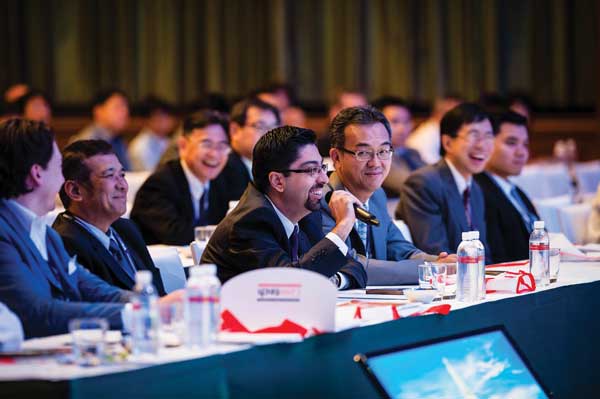
Topics also generated lively question-and-answer sessions
Alternative fuels and WHR
Further presentations engaged with technologies for successful alternative fuels systems suited to the Asian cement industry.
Brian McGrath, representing ResourceCo Asia (Singapore), provided a useful review of both the economic and technical challenges and benefits of using refuse-derived fuel (RDF). He also provided an example of an RDF preparation facility established at Ipoh in Malaysia, which is now selling engineered fuels successfully to local producers.
Luc Rieffel, Walters Materials Handling/ATS Group (France), explored a project at Siam City Cement Co, Thailand, where an automatic crane and dosing system feeds both fine and coarse RDF to the calciner at a rate of 10tph.
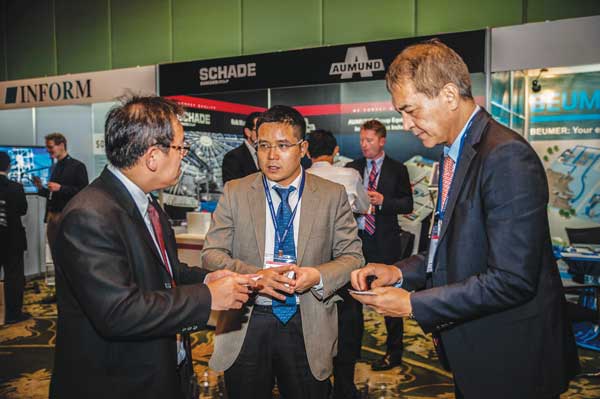
Cemtech Asia also provided ample opportunity to network and
ask detailed questions in its 25-stand exhibition
Andreas Renetzeder, Scheuch GmbH (Austria), provided an overview of this company’s solutions for emissions reduction using state-of-the-art baghouse technology. He also covered SCR for NOx-reduction and a groundbreaking multi-pollutant control system based on conditioned dry-sorption technology for the reduction of mercury, SOx, HCI, HF, dioxins and VOCs.
Hakan Uvez, technical director for Asia Cement plc, Italcementi’s Thai subsidiary, led delegates through the commissioning of the waste heat recovery (WHR) system for the Pukrang cement plant. Supplied by Anhui Conch Kawasaki, the system recovers waste heat from two cement kiln lines, using the steam Rankine cycle to generate a gross electricity output of 21.1MWe. The project was completed in 18 months at a cost of THB1.22bn (US$35m), and now covers 25 per cent of in-house power consumption.
Grinding advances
A highlight in the technical programme was Jean-Marc Reginster’s presentation on operational experiences with vertical roller mills by HeidelbergCement at four key references within the Asia Pacific. The strengths and weaknesses of four VRM mills by different suppliers were contrasted and some key observations highlighted. While ball mills are easier to operate at stable conditions given variable clinker sources, VRMs are generally favoured by HeidelbergCement for their versatility and ability to grind a wider product range. VRMs do, however, require a much higher level of operator skill, including specialised knowledge in hydraulics, as well as careful maintenance.
Technologies for optimised grinding were also addressed by Jorg Schrabback, Sika Services AG (Germany), who made a typically accomplished presentation on the technical challenges and benefits of using limestone as a clinker replacement. Experiences in Vietnam were used to illustrate how Sika’s grinding aids could offer four per cent clinker reduction, significant strength enhancement with resulting savings amounting to US$0.20/t cement.
Downstream technology
Stuart Barton, Xoptix (UK), introduced a new sampling technology for particle size measurement for cement production, which is able to offer real time in-process analysis at a lower cost than conventional laboratory equipment.
A productive session on bulk material handling, storage and transportation included the presentation by Fernando Libonati of Aumund on the company’s new high-capacity triple bucket elevator. This development is driven by increasing mill capacities and will be able to handle capacity of up to 4000tph.
Roel Castaño, co-founder of Geometrica (USA), a company which specialises in covering bulk stockpiles using its innovative geodesic dome technology, presented case studies to demonstrate the cost-effectiveness of this solution.
A lively session concluded the conference programme: Beumer showcased its palletless packaging system now installed at TPI Polene’s Saraburi plant in Thailand and Holcim’s Lugait plant in the Philippines.
Impressive plant tour
Cemtech Asia 2015 main sponsor, SCG Cement (Thailand), opened the doors of its impressive 7.3Mta Kaeng Khoi cement plant in Saraburi province to 40 delegates who participated in the field trip.
Kaeng Khoi’s four precalciner kilns are equipped with waste heat recovery technology, giving the plant a total power generation capacity of 31.7MW – or 35 per cent of the plant’s electricity usage.
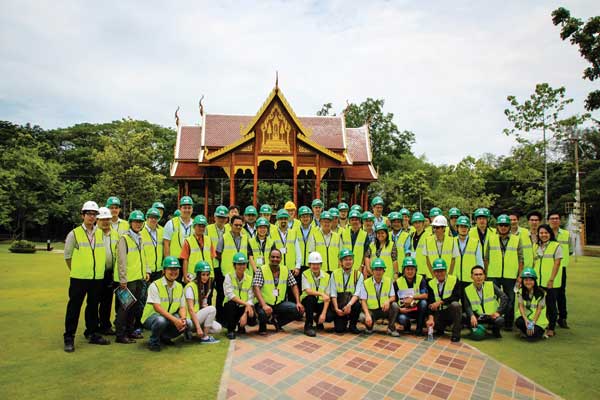
Siam Cement Group, sponsors of Cemtech Asia 2015, also hosted the event’s plant visit to
its impressive 7.3Mta Kaeng Khoi cement plant in Saraburi province
Time for training
The Cemtech Technical Workshop, featuring a three-day plant optimisation training course, took place alongside the main event. The course saw participants engage in a variety of topics relating to cement manufacturing technology best practice.
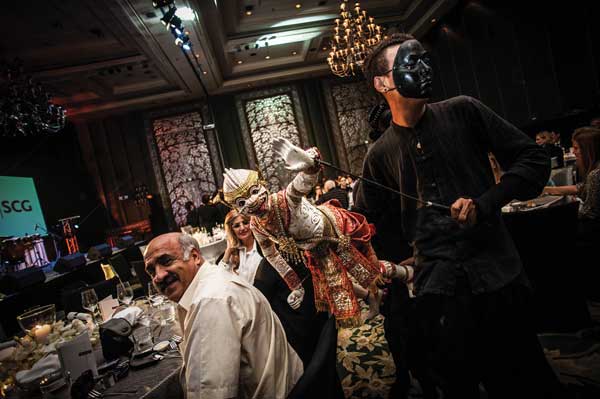
Guests at the sumptuous Gala Dinner were entertained by a traditional Thai puppet show
Next Cemtech
The forthcoming Cemtech Europe 2015 conference and exhibition will be held at the InterContinental Vienna, Austria, on 20-23 September 2015. Registration is now open.
This article was first published in International Cement Review, August 2015.

